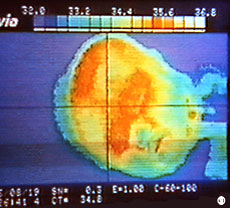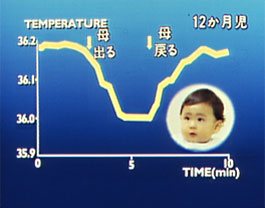Also, student unrest is not unrelated to the emergence and development of new ideas in medical research, including to the study of children, particularly, of babies, I believe. In the late 70s, I started to study infant behavior in relation to "immunology." The reason I will explain later. Prof. Konishi was probably studying neonatology at that time. At the same time, psychologists also had started to study babies independently in Japan.
Of course, these developments were very much influenced by Bolby's Attachment Theory, and further by Klaus and Kennell's idea of "Maternal Infant Bonding" and "Mother-Infant Interaction."
I know that in Europe and the USA, they started research on babies much earlier than in Japan. This research, outside of Japan, also played an important role in stimulating not only pediatricians but also psychologists in Japan to start their research. I must say that the Japanese Society of Developmental Psychology, for which I also worked, was established in 1989, 17 years ago.
It was in 1997 that Prof. Konishi and I organized the Japanese Society of Infant Behavioral Development Study. As far as I recall, we had only 200 or so society members, and have had five meetings since then. At the last meeting in 2000, we invited Prof. G. Butterworth from the UK and had a very fruitful time in Tokyo. But unfortunately he passed away suddenly after returning to the UK. It was very sad memory for us, and I wish to express my deepest condolences.
In 2001, Prof. Konishi and I decided to reorganize the infant behavior society, and changed the name to the Japanese Society of Baby Science (JSBS), in order to expand and activate the society. This reorganization did produce an unexpected effect. It was much more noticed by the media than before, probably due to children's issues then becoming urgent in society, also to the term "baby" in the name of the society which sounds much softer to the Japanese public compared to the word "infant." Sankei Shimbun, one of the leading national newspapers, started holding the international symposium of baby science every year as well as publishing a series of scientific articles on baby science, to introduce not only Japanese studies but also studies outside of Japan. Finally, Professor J. Compos was invited to this international conference 3 years ago, that is, in 2003. This is the starting point of the ICIS and JSBS collaboration, which has finally culminated in this Kyoto meeting.
Let me tell you about my personal background, as well as that of Prof. Konishi, and why we started to have an interest in studying baby's behavior. I myself am a pediatric allergist and immunologist. When I read Klaus and Kennell's book, "Maternal Infant Bonding," I was shocked to learn of Condon's work on "entrainment" of the baby's body movement to adult speech. I was even ashamed of myself as a pediatrician for knowing nothing about the neonate having such an ability to synchronize body movement with adult speech rhythm. At the same time, "mother-infant interaction" seemed similar to Tcell-Bcell interaction in immunology, which was a big analogy for me.
The entrainment of the mother's voice and baby's body movement, in another way, is considered not only to make the mother-infant bond but also language development, that is, the biological mechanism to take in culture as language. When I thought about this, I was so excited and decided to prove Condon's work by more sophisticated means, that is, by computer pattern analysis, although the computer itself was very limited in capacity then for this purpose.
Prof. Konishi is different from myself, since he is a well trained neonatologist, neurologist and a very good clinician, and further a very good observer. He studied left and right handedness of neonates during his neonatal service, and later studied the spontaneous movement of neonates under Professor Prechitel.
It was an unexpected but very pleasurable occasion for me to meet Prof. Konishi at first, who had asked me to organize a group to study baby behavior, particularly since I was already interested in the behavioral study. Furthermore, at that time, pediatricians, even neurologists and neonatiologists in general paid very little attention to behavior and were interested only in reflex. So I agreed to establish this society together with Prof. Konishi in order to introduce a new movement into pediatric circles to organize a multidisciplinary group, although I was already retired from the National Children's Hospital then. This was finally materialized into JSBS, as I have mentioned.
I would like to explain what we had done to prove W. S. Condon's finding, since Prof. N. Ishiki as moderator mentioned our study at the beginning of this symposium. Prof. Ishiki has made a great contribution in introducing new ideas regarding babies' abilities, as well as the importance of parenting and child care as a producer at NHK Television, when I was in the most active phase of baby's studies in my life.
I will show a few slides of my research to confirm Condon's work by a new method using a computer pattern analysis, for your interest. I was lucky, since I had already started quantitative evaluation of morphology of leukemic cells and lymphocyte with Prof. T. Ishii. He was my classmate at the medical school and a very intelligent and capable man, who became an information scientist after passing the National Board of Examination to have graduated from the engineering school.
Fig.3
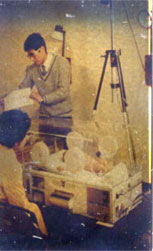 Fig.3 photo shows how we recorded the baby's hand movement by video camera. Here you can see a young post-graduate student of Prof. Ishii. Now he is Professor T. Watanabe, who is a very important member of JSBS. He is now studying to design robotics to facilitate interpersonal communication based on our study.
Fig.3 photo shows how we recorded the baby's hand movement by video camera. Here you can see a young post-graduate student of Prof. Ishii. Now he is Professor T. Watanabe, who is a very important member of JSBS. He is now studying to design robotics to facilitate interpersonal communication based on our study.
Fig.4 is a picture of a baby, say 2 or 3 days old, who is moving his hand, while the mother talks freely to him, "Here is Mama, my dear sweetie", or something like that.
Here I will show you how we performed the quantitative evaluation of hand movement. As you see in Fig.5, we counted the appearance and the disappearance of pickcells of the hand, after processing the original frame into matrices and then into pickcells. You can imagine that the computer was not sophisticated enough to make subtraction easily then.
In this way, we obtained the two curves, that is, the curves of the baby's hand movement, and the curve of the mother's voice
(Fig.6). We then calculated the cross correlation curves of the baby's hand movement and the mother's speech rhythm(Fig.7). (A) is the result; when the mother is talking freely to her baby, we see two peaks. The left peak shows the baby's hand movement entrained to the mother's speech. The right peak shows the mother's speech entrained to the baby's movement. (B) shows the result when the mother is reading sentences of her speech without looking at the baby. It shows only one peak, that is, the baby's hand movement is entrained to the mother's speech, but the right peak has disappeared. (C) is the control. It shows no entrained peak, when the baby was listening the combined mother's voices of tape record were cut in a random way.
In an other study, we examined the baby's emotional response evaluated by thermography. Fig.8 is a thermograph of the baby's face. There are areas in the forehead, where the skin temperature was lowered, when the baby was separated from the mother. This is the first application of thermography to emotional evolution, and it was successful at that time.
Of course, these developments were very much influenced by Bolby's Attachment Theory, and further by Klaus and Kennell's idea of "Maternal Infant Bonding" and "Mother-Infant Interaction."
I know that in Europe and the USA, they started research on babies much earlier than in Japan. This research, outside of Japan, also played an important role in stimulating not only pediatricians but also psychologists in Japan to start their research. I must say that the Japanese Society of Developmental Psychology, for which I also worked, was established in 1989, 17 years ago.
It was in 1997 that Prof. Konishi and I organized the Japanese Society of Infant Behavioral Development Study. As far as I recall, we had only 200 or so society members, and have had five meetings since then. At the last meeting in 2000, we invited Prof. G. Butterworth from the UK and had a very fruitful time in Tokyo. But unfortunately he passed away suddenly after returning to the UK. It was very sad memory for us, and I wish to express my deepest condolences.
In 2001, Prof. Konishi and I decided to reorganize the infant behavior society, and changed the name to the Japanese Society of Baby Science (JSBS), in order to expand and activate the society. This reorganization did produce an unexpected effect. It was much more noticed by the media than before, probably due to children's issues then becoming urgent in society, also to the term "baby" in the name of the society which sounds much softer to the Japanese public compared to the word "infant." Sankei Shimbun, one of the leading national newspapers, started holding the international symposium of baby science every year as well as publishing a series of scientific articles on baby science, to introduce not only Japanese studies but also studies outside of Japan. Finally, Professor J. Compos was invited to this international conference 3 years ago, that is, in 2003. This is the starting point of the ICIS and JSBS collaboration, which has finally culminated in this Kyoto meeting.
Let me tell you about my personal background, as well as that of Prof. Konishi, and why we started to have an interest in studying baby's behavior. I myself am a pediatric allergist and immunologist. When I read Klaus and Kennell's book, "Maternal Infant Bonding," I was shocked to learn of Condon's work on "entrainment" of the baby's body movement to adult speech. I was even ashamed of myself as a pediatrician for knowing nothing about the neonate having such an ability to synchronize body movement with adult speech rhythm. At the same time, "mother-infant interaction" seemed similar to Tcell-Bcell interaction in immunology, which was a big analogy for me.
The entrainment of the mother's voice and baby's body movement, in another way, is considered not only to make the mother-infant bond but also language development, that is, the biological mechanism to take in culture as language. When I thought about this, I was so excited and decided to prove Condon's work by more sophisticated means, that is, by computer pattern analysis, although the computer itself was very limited in capacity then for this purpose.
Prof. Konishi is different from myself, since he is a well trained neonatologist, neurologist and a very good clinician, and further a very good observer. He studied left and right handedness of neonates during his neonatal service, and later studied the spontaneous movement of neonates under Professor Prechitel.
It was an unexpected but very pleasurable occasion for me to meet Prof. Konishi at first, who had asked me to organize a group to study baby behavior, particularly since I was already interested in the behavioral study. Furthermore, at that time, pediatricians, even neurologists and neonatiologists in general paid very little attention to behavior and were interested only in reflex. So I agreed to establish this society together with Prof. Konishi in order to introduce a new movement into pediatric circles to organize a multidisciplinary group, although I was already retired from the National Children's Hospital then. This was finally materialized into JSBS, as I have mentioned.
I would like to explain what we had done to prove W. S. Condon's finding, since Prof. N. Ishiki as moderator mentioned our study at the beginning of this symposium. Prof. Ishiki has made a great contribution in introducing new ideas regarding babies' abilities, as well as the importance of parenting and child care as a producer at NHK Television, when I was in the most active phase of baby's studies in my life.
I will show a few slides of my research to confirm Condon's work by a new method using a computer pattern analysis, for your interest. I was lucky, since I had already started quantitative evaluation of morphology of leukemic cells and lymphocyte with Prof. T. Ishii. He was my classmate at the medical school and a very intelligent and capable man, who became an information scientist after passing the National Board of Examination to have graduated from the engineering school.
Fig.3
 Fig.3 photo shows how we recorded the baby's hand movement by video camera. Here you can see a young post-graduate student of Prof. Ishii. Now he is Professor T. Watanabe, who is a very important member of JSBS. He is now studying to design robotics to facilitate interpersonal communication based on our study.
Fig.3 photo shows how we recorded the baby's hand movement by video camera. Here you can see a young post-graduate student of Prof. Ishii. Now he is Professor T. Watanabe, who is a very important member of JSBS. He is now studying to design robotics to facilitate interpersonal communication based on our study.
Fig.4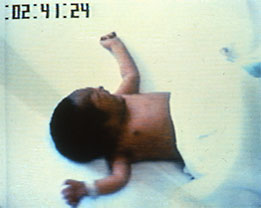 |
|
Fig.5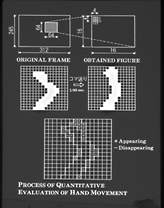 |
Fig.4 is a picture of a baby, say 2 or 3 days old, who is moving his hand, while the mother talks freely to him, "Here is Mama, my dear sweetie", or something like that.
Here I will show you how we performed the quantitative evaluation of hand movement. As you see in Fig.5, we counted the appearance and the disappearance of pickcells of the hand, after processing the original frame into matrices and then into pickcells. You can imagine that the computer was not sophisticated enough to make subtraction easily then.
|
Fig.6 |
|
Fig.7 |
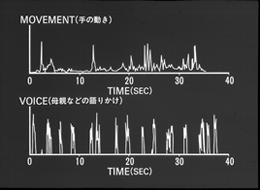 |
|
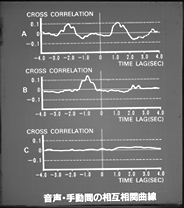 |
In this way, we obtained the two curves, that is, the curves of the baby's hand movement, and the curve of the mother's voice
(Fig.6). We then calculated the cross correlation curves of the baby's hand movement and the mother's speech rhythm(Fig.7). (A) is the result; when the mother is talking freely to her baby, we see two peaks. The left peak shows the baby's hand movement entrained to the mother's speech. The right peak shows the mother's speech entrained to the baby's movement. (B) shows the result when the mother is reading sentences of her speech without looking at the baby. It shows only one peak, that is, the baby's hand movement is entrained to the mother's speech, but the right peak has disappeared. (C) is the control. It shows no entrained peak, when the baby was listening the combined mother's voices of tape record were cut in a random way.
In an other study, we examined the baby's emotional response evaluated by thermography. Fig.8 is a thermograph of the baby's face. There are areas in the forehead, where the skin temperature was lowered, when the baby was separated from the mother. This is the first application of thermography to emotional evolution, and it was successful at that time.
Fig.9 shows a representative response. The right vertical line indicates skin temperature of an infant's face. When the mother was leaving the baby, the facial temperature got lower, but when the mother was returning to the baby, the temperature was rose to the level before separation. Before closing, I would like to mention the reason why we picked the name "baby science," instead of "infant studies" or "infant research." This was related to the student unrest that was taking place at the time. In an affluent society, we then faced and still face various issues, particularly related to the ways of human existence. Against this background, we became aware of discussion on a comprehensive holistic approach versus the reductionist approach to these issues. As you know, "Human Science" is a science that is representative of the holistic approach to human issues. The same can be said about Child Science and Baby Science. In this respect, I have learnt a lot from the J.Z. Young's book "An Introduction to Study of Man," Oxford at the Clarendon Press, 1971. In my view, Baby Science is a holistic, comprehensive multidisciplinary, or even transdisciplinary science of infants. With this in mind, when we choose the name "baby science," I thought that "baby" would indicate no specific scientific background. In other words, we felt we had to integrate reductionist sciences in the study of the baby, child, and human being. That was our idea, If you take a look at the constituent members of JSBS, this is quite clear. Of course, physicians, neuroscientists and others, who have a medical background, are the highest in number, occupying nearly 50% of the membership. But, there are many other types of scientists, such as psychologists, education scientists, information engineers, complex system scientists, robotic scientists, and primate scientists. There are also many practitioners, child care workers, nursery teachers, journalists and even parents. Finally, I would like to close my talk by saying "the life is strange, but very enjoyable anyway". When I was elected to the Vice President, President Elect of International Pediatric Association at the New Deli Congress in 1977, I met Prof. L. Stern, who was a very charming and bright neonatologist. He invited me to come to Brown University. Probably in 1978 or 1979, I visited the Brown University Medical Center, where I met Professor L. P. Lipsitt for the first time. This was the beginning of our friendship. I understand that this is the fourth visit to Japan for him. I am deeply moved to meet Prof. Lipsitt in this way at this international conference, and am very honored to see you here again. I thank you. (This article is based on a rewritten presentation first made at the Funder's Symposium, "Infant Studies and Baby Science in the future" in the 15th ICIS at Kyoto on 21st July, 2006.) |



